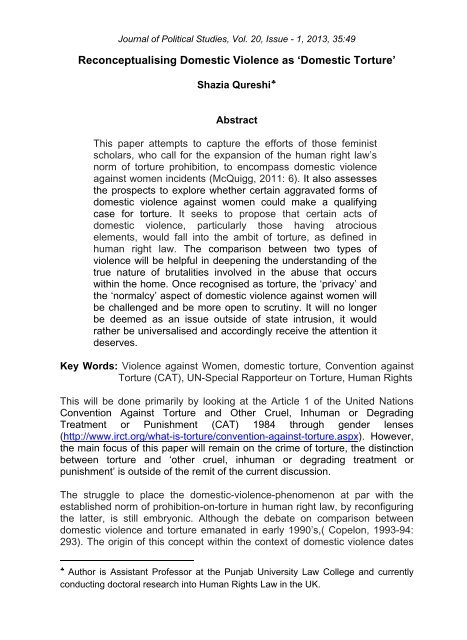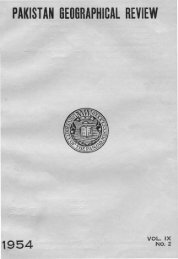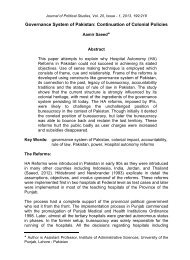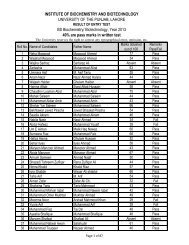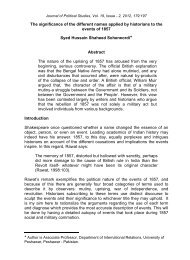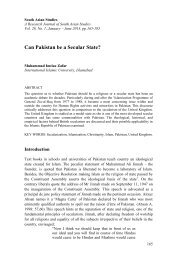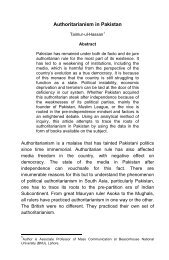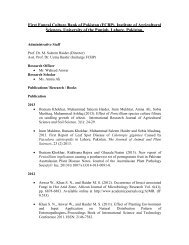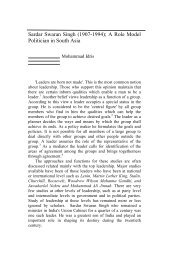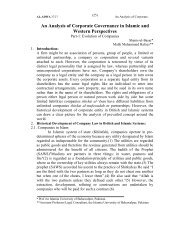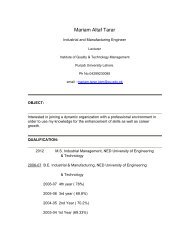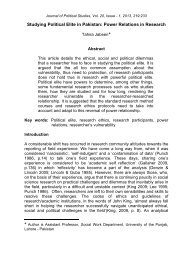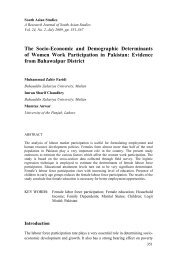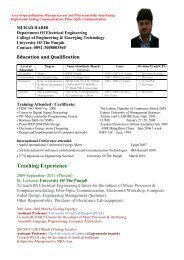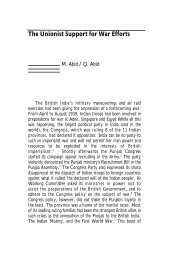Reconceptualising Domestic Violence as 'Domestic Torture'
Reconceptualising Domestic Violence as 'Domestic Torture'
Reconceptualising Domestic Violence as 'Domestic Torture'
You also want an ePaper? Increase the reach of your titles
YUMPU automatically turns print PDFs into web optimized ePapers that Google loves.
Journal of Political Studies, Vol. 20, Issue - 1, 2013, 35:49<br />
<strong>Reconceptualising</strong> <strong>Domestic</strong> <strong>Violence</strong> <strong>as</strong> ‘<strong>Domestic</strong> Torture’<br />
Shazia Qureshi ♣<br />
Abstract<br />
This paper attempts to capture the efforts of those feminist<br />
scholars, who call for the expansion of the human right law’s<br />
norm of torture prohibition, to encomp<strong>as</strong>s domestic violence<br />
against women incidents (McQuigg, 2011: 6). It also <strong>as</strong>sesses<br />
the prospects to explore whether certain aggravated forms of<br />
domestic violence against women could make a qualifying<br />
c<strong>as</strong>e for torture. It seeks to propose that certain acts of<br />
domestic violence, particularly those having atrocious<br />
elements, would fall into the ambit of torture, <strong>as</strong> defined in<br />
human right law. The comparison between two types of<br />
violence will be helpful in deepening the understanding of the<br />
true nature of brutalities involved in the abuse that occurs<br />
within the home. Once recognised <strong>as</strong> torture, the ‘privacy’ and<br />
the ‘normalcy’ <strong>as</strong>pect of domestic violence against women will<br />
be challenged and be more open to scrutiny. It will no longer<br />
be deemed <strong>as</strong> an issue outside of state intrusion, it would<br />
rather be universalised and accordingly receive the attention it<br />
deserves.<br />
Key Words: <strong>Violence</strong> against Women, domestic torture, Convention against<br />
Torture (CAT), UN-Special Rapporteur on Torture, Human Rights<br />
This will be done primarily by looking at the Article 1 of the United Nations<br />
Convention Against Torture and Other Cruel, Inhuman or Degrading<br />
Treatment or Punishment (CAT) 1984 through gender lenses<br />
(http://www.irct.org/what-is-torture/convention-against-torture.<strong>as</strong>px). However,<br />
the main focus of this paper will remain on the crime of torture, the distinction<br />
between torture and ‘other cruel, inhuman or degrading treatment or<br />
punishment’ is outside of the remit of the current discussion.<br />
The struggle to place the domestic-violence-phenomenon at par with the<br />
established norm of prohibition-on-torture in human right law, by reconfiguring<br />
the latter, is still embryonic. Although the debate on comparison between<br />
domestic violence and torture emanated in early 1990’s,( Copelon, 1993-94:<br />
293). The origin of this concept within the context of domestic violence dates<br />
♣ Author is Assistant Professor at the Punjab University Law College and currently<br />
conducting doctoral research into Human Rights Law in the UK.
Shazia Qureshi<br />
back to 1878 (Cobbe,1878: 55-87). Cobb, the distinguished activist of the<br />
Victorian feminism, whose work on law reform is well recognized in England,<br />
w<strong>as</strong> much ahead of her time in describing domestic violence <strong>as</strong> torture<br />
(https://pi.library.yorku.ca/ojs/index.php/topia/article/viewFile/441/12258)<br />
Cobbe’s influence w<strong>as</strong> most felt through her writings, she published an article<br />
‘Wife Torture in England’ to support a new bill then presented in parliament<br />
(Cobbe,1878). Cobbe had noted that:<br />
..the unendurable mischief, the discovery of which h<strong>as</strong> driven<br />
me to try to call public attention to the whole matter, is this—<br />
wife beating in process of time and in numberless c<strong>as</strong>es,<br />
advances to wife torture and the wife torture usually ends in<br />
wife maiming, wife blinding or wife murder (Cobbe,1878: 72).<br />
She supported her arguments with statistics of femicide and numerous<br />
accounts of extreme brutality carried out by men in the home. Matrimonial<br />
Causes Acts 1878 w<strong>as</strong> p<strong>as</strong>sed <strong>as</strong> a result, her major achievement in this<br />
regard that enabled battered wives to obtain separation orders against their<br />
abusive husbands. That being said, Cobbe’s reconception of domestic<br />
violence <strong>as</strong> torture perhaps w<strong>as</strong> neither meant in the sense in which it is<br />
understood in the International human rights law nor w<strong>as</strong> it done with an<br />
intention to attain any goal in this realm. Instead her primary purpose of using<br />
this terminology w<strong>as</strong>, arguably, to equate the quantum of pain/suffering<br />
involved in the two forms of violence. By so doing she sought to expand legal<br />
options available to women victims of domestic violence within UK.<br />
It is in the 1990s that feminist legal activism, recognizing the striking parallels<br />
between the two forms of violence, put forward the concept of domestic<br />
violence <strong>as</strong> torture (Edward, 2006: 350-51). The analogies between domestic<br />
violence and torture were drawn b<strong>as</strong>ically to bring the former into the folds of<br />
HRL or more specifically to attract the provisions of the CAT (Copelon, 1993-<br />
94:299 & Youngs, 2003: 1220-21). To this end some feminist writers stress<br />
the need to channel the potential force of human rights norms, including<br />
prohibition on torture. This force arguably can be redesignated to the VAW<br />
c<strong>as</strong>es with greater tenacity and commitment than already h<strong>as</strong> been the c<strong>as</strong>e<br />
(McGlynn, 2008: 72). Copelon argues that her primary goal in this regard is to<br />
‘challenge the <strong>as</strong>sumption that intimate violence is less severe and terrible<br />
than that perpetrated by the state’ (Copelon, 1993-94: 352). She holds that<br />
such violence must be understood <strong>as</strong> torture, giving rise to international and<br />
national obligations (Copelon, 1993-94:296). Also it h<strong>as</strong> been recognized that<br />
an issue can only be properly addressed in law if it is accurately<br />
conceptualized (Meyersfelds, 2003-04:374). MacKinnon suggests that<br />
understanding various types of VAW within the ‘recognized profile’ of torture<br />
would contribute to the recognition of such abuses <strong>as</strong> a serious human rights<br />
concern (Mackinnon, 2006:17). Moreover, by recognizing the power of<br />
36
<strong>Reconceptualising</strong> <strong>Domestic</strong> <strong>Violence</strong> <strong>as</strong> ‘<strong>Domestic</strong> Torture’<br />
naming, it can be used <strong>as</strong> a strong rhetorical strategy (CAT, 2007: 3). As<br />
varying degrees of abuses exists across the spectrum of violence, ranging<br />
from minor infrequent abuses to extreme brutalities, treating them in the same<br />
way and labelling all of them <strong>as</strong> domestic violence will not be justifiable<br />
(Meyersfelds, 2003-04: 376). Instead, redefining acute forms of domestic<br />
violence <strong>as</strong> torture, and maintaining that it is <strong>as</strong> pernicious and harmful <strong>as</strong> the<br />
torture inflicted by the state officials, would help trigger effective legal<br />
responses both at domestic and international levels (Meyersfelds, 2003-04:<br />
375 & Youngs, 2003: 1220-21). Therefore, violence that p<strong>as</strong>ses the threshold<br />
of torture can be distinguished from other forms of violence on three grounds,<br />
i.e. repetition, power and severity (Meyersfelds, 2003-04: 390). It is argued<br />
that domestic violence having these characteristics would create a pattern of<br />
brutality which fulfils the criterion of torture, for the purposes of present<br />
discussion this will be referred to <strong>as</strong> <strong>Domestic</strong> Torture.<br />
Notably, the prohibition of torture h<strong>as</strong> been reiterated in several widely ratified<br />
international and regional treaties, Such <strong>as</strong>, Article 5 Universal Declaration of<br />
Human Rights 1948, Common Article 3 of four Geneva Conventions, Article<br />
7&10 International Covenant of Civil and Political Rights 1966, The Articles<br />
7,8 Statute of International Criminal Court, The European Convention for the<br />
Prevention of Torture and Inhuman and Degrading Treatment or Punishment<br />
1987, The Inter-American Convention to Prevent and Punish Torture 1985, to<br />
name few and it clearly forms the part of customary international law<br />
(McCorquodale & Forgia,2001: 190). Further in view of the significant nature<br />
of the values protected by this norm, it arguably, h<strong>as</strong> attained the status of jus<br />
cogens (McCorquodale & Forgia, 2001: 190 & Copelon, 1993-94: 297).<br />
Accordingly, by aligning domestic violence with torture, it is suggested that<br />
such violence should be recognized equally heinous violation of human rights,<br />
and thus be accepted <strong>as</strong> a rule of jus cogens (Copelon, 1993-94: 299). To<br />
define any phenomenon within the meaning of torture, the traditional starting<br />
point is Article 7 of ICCPR that lays down the b<strong>as</strong>is of prohibition on torture,<br />
later giving rise to the entire international treaty, dealing with different <strong>as</strong>pects<br />
of this particular right. Article 7 of ICCPR prohibits torture in unequivocal<br />
terms, it states:<br />
“No one shall be subjected to torture or to cruel, inhuman or<br />
degrading treatment or punishment. In particular, no one shall<br />
be subjected without his free consent to medical or scientific<br />
experimentation”<br />
The Convention against Torture and Other Cruel, Inhuman or Degrading<br />
Treatment or Punishment 1984 (CAT) is an exclusive international treaty<br />
devoted to the subject of torture and mandates an absolute prohibition of<br />
torture worldwide. However, it is inherently afflicted with the separation of<br />
sphere infirmity of Western liberal thought (Chinkin,1999: 389). This exposed<br />
37
Shazia Qureshi<br />
the provisions of CAT to intense criticism by many feminists. Article 1 of CAT<br />
defines torture in the following words:<br />
For the purposes of this Convention, torture means any act by<br />
which severe pain or suffering, whether physical or mental, is<br />
intentionally inflicted on a person for such purposes <strong>as</strong><br />
obtaining from him or a third person information or a<br />
confession, punishing him for an act he or a third person h<strong>as</strong><br />
committed or is suspected of having committed, or intimidating<br />
or coercing him or a third person, or for any re<strong>as</strong>on b<strong>as</strong>ed on<br />
discrimination of any kind, when such pain or suffering is<br />
inflicted by or at the instigation of or with the consent or<br />
acquiescence of a public official or other person acting in an<br />
official capacity. It does not include pain or suffering arising<br />
only from, inherent in or incidental to lawful sanctions.<br />
(emph<strong>as</strong>is added)<br />
As the text of article 7 of the ICCPR does not use the phr<strong>as</strong>es such <strong>as</strong> ‘public<br />
officials’ or ‘person acting in official capacity’, its scope is viewed wider, by<br />
some feminists, compared to the CAT. Since the overall subject matter of<br />
ICCPR pertains to those rights that fall into the category of public sphere,<br />
arguably, the existence of state involvement element is perceived to be<br />
understood. The CAT’s excessive emph<strong>as</strong>is on public realm is most criticized<br />
by some feminist scholars (Charlesworth & Chinkin 1993: 72). Only the<br />
abuses perpetrated by agents of the state are recognized <strong>as</strong> torture<br />
(Byrnes,1988-89: 218). Additionally, law’s standard practice of using<br />
m<strong>as</strong>culine vocabulary, to which the CAT is not an exception, tends to suggest<br />
that prohibition on torture represent a male right rather than a human right<br />
(Edward, 2006: 354-355). The dynamics of the gendered nature of<br />
international law/HRL h<strong>as</strong> been succinctly described by MacKinnon in the<br />
following words ‘When men sit in rooms, being states, they are largely being<br />
men’ (Mackinnon,1994: 15). For this re<strong>as</strong>on, she argues, they do not, and<br />
cannot, represent women’s interests. From a traditional view point state<br />
complicity is generally a sine qua non of the notion of torture. The male<br />
privileging approach and gender exclusionary trend underpinning the CAT h<strong>as</strong><br />
failed to integrate the experiences of women’s lives (Charlesworth & Chinkin<br />
1993: 70). Arguably women are more likely to suffer violence at the hands of<br />
private individuals and/or within the familial context than by public officials,<br />
outside of domestic sphere (Edward, 2006: 353, Youngs, 2003: 1213,<br />
McQuigg, 2011: 7 & Benninger-Budel, 2008: 4). However, the CAT, for the<br />
re<strong>as</strong>ons cited above, is more applicable to and corresponds with the realities<br />
of men’s lives. Noting that activities predominantly relating to men’s life fall<br />
within the protective range of the CAT, Mackinnon remarks ‘when a woman is<br />
tortured by her husband in her home, humanity is not violated’<br />
(Mackinnon,1994: 6).<br />
38
<strong>Reconceptualising</strong> <strong>Domestic</strong> <strong>Violence</strong> <strong>as</strong> ‘<strong>Domestic</strong> Torture’<br />
Three key elements can be distilled from the definition of the CAT’s article 1.<br />
First is the nature of act itself, it requires some serious degree of torment<br />
/suffering, may it be physical or mental (McCorquodale & Forgia, 2001: 92,<br />
Copelon, 1993-94: 308). Second is the objective/mental element, it relates to<br />
the intention of the perpetrator at the time of infliction of harm. This means the<br />
mere act of causing severe harm to another is not sufficient, unless such harm<br />
is caused by the perpetrator with a specific purpose in mind, including an<br />
intention to secure some kind of information (McCorquodale & Forgia,2001:<br />
92). Nevertheless, there is nothing to indicate that this list of purposes is<br />
exhaustive, the provision is rather open to continual embracing of additional<br />
purposes (Fortin, 2008: 146). The third requirement relates to the identity of<br />
the perpetrator. The perpetrator of torture must be a public official, or any<br />
other person acting in such capacity or with the express or implied consent of<br />
such official. This would cover the c<strong>as</strong>es even when the person acting under<br />
the colour of law exceeds his authority. It is the l<strong>as</strong>t element which is seen <strong>as</strong><br />
a major obstacle for the extreme domestic violence c<strong>as</strong>es to qualify <strong>as</strong> torture<br />
and therefore central area of concern for most feminists. The third element<br />
will be mostly focused in the ensuing discussion.<br />
As regards the first element it is argued that extreme acts of cruelty in<br />
domestic violence c<strong>as</strong>es are severe enough to p<strong>as</strong>s the torture threshold<br />
(McCorquodale & Forgia, 2001: 191). Many feminists contend and<br />
authenticate through, testimonies, statistical records, women’s tribunals and<br />
scholarly work that in some c<strong>as</strong>es the harm caused by the batterer is <strong>as</strong><br />
serious <strong>as</strong> that perpetrated by state agents (Copelon,2003: 870) . The<br />
Canadian panel on VAW report noted that the level of victimisation and<br />
degrees of torture in some domestic violence c<strong>as</strong>es that included ‘years of<br />
terrorism in relationship’ can only be compared to ‘torture to a prisoner of war<br />
camp’(Copelon, 1993-94: 45-47). Copelon argues that the methods of acute<br />
domestic violence simulate the common methods of torture (Copelon, 1993-<br />
94: 311, Youngs, 2003 :1222. & McQuigg, 2011: 6).<br />
Curiously, batterers do not receive any formal training for torture, yet the<br />
methods of abuse not only coincide with those of the other batterers’ but also<br />
bear resemblance with torture inflicted by state officials. It h<strong>as</strong> been observed<br />
that, continuing, frequent and extreme acts of domestic violence produce<br />
equally damaging and long term effects in victims of abuse (Youngs, 2003:<br />
1221).<br />
Psychological and physical sufferings of women experiencing violence in their<br />
everyday life are no less dev<strong>as</strong>tating than the torture inflicted by state agents<br />
(Youngs, 2003: 1222). The physical acts consists of inter alia punching,<br />
strangling, burning, kicking etc which are commonly used both by batterers<br />
and state agents upon victims of tortures (Copelon, 1993-94: 311 &<br />
Meyersfeld, 2003-04:411 ). On the psychological side, women victims suffer<br />
39
Shazia Qureshi<br />
anguish, humiliation, fear, isolation, and disintegration of self , similar to the<br />
psychological conditions of a prisoner in concentration camp or a political<br />
captive (Copelon, 1993-94: 313). Herman developed the term ‘complex post<br />
traumatic stress syndrome’ which would adequately describe the intense<br />
psychological symptoms of torture both upon the minds of battered woman<br />
and political prisoners (Hermand,1992: 77 & 119). She argues that violence<br />
inflicted by the state official may not necessarily be more annihilating than by<br />
intimate partner. It is rather argued, that the violence carried out by an intimate<br />
partner h<strong>as</strong> a potential to cause more psychological harm than violence<br />
inflicted by a strange state oppressor (Hermand,1992: 76-79). In summation<br />
what makes experiencing domestic violence excruciatingly painful in<br />
psychological terms is the element of breach of trust by the intimate partner.<br />
When violence comes from a source wherefrom it is le<strong>as</strong>t expected, the<br />
psychological trauma of the victim is quite understandable. Arguably, in that<br />
sense battering and torture could be treated at par, regardless of the level of<br />
harm endured or torturing techniques employed by the abusive partner or<br />
state official.<br />
The second element identified in CAT’s definition relates to the<br />
intention/purpose of the person who inflicts torture. Various commentators<br />
have given considerable attention to this <strong>as</strong>pect of torture, and there seems to<br />
be an agreement about the ‘common aim’ that any perpetrator of torture might<br />
seek to achieve. It is argued that the different techniques for torture are<br />
b<strong>as</strong>ically designed with a purpose to debilitate a victim’s moral resistance and<br />
to finally break his/her will (http://www.violenceisnotourculture.org<br />
/resources/%E2%80%9Cstrengthening-protection-women-torture-and-illtreatment%E2%80%9D-statement-manfred-nowak).<br />
As Compagnoni argues:<br />
Torture tends to the disintegration and consequent annihilation<br />
of the psychic and moral personality, to the non-physical<br />
destruction, practically speaking, of the human person, with<br />
long l<strong>as</strong>ting results (Peters, 1996: 87).<br />
A similar idea is presented by Edward when he concludes:<br />
It is not primarily the victim's information, but the victim, that<br />
torture needs to win - or reduce to powerlessness (Peters,<br />
1996).<br />
Just <strong>as</strong> torture aims to incapacitate the victims and control their will, the use of<br />
violence by the batterer tends to regulate the woman’s will. Attacks on<br />
person’s autonomy, integrity and selfhood to gain access to his/her mind are<br />
widely cited torture techniques. This can be achieved through a myriad of<br />
ways in the context of domestic torture, such <strong>as</strong> by placing constraints on<br />
women’s life choices including sexuality and restrictions on freedom of<br />
40
<strong>Reconceptualising</strong> <strong>Domestic</strong> <strong>Violence</strong> <strong>as</strong> ‘<strong>Domestic</strong> Torture’<br />
movement. Likewise, gross humiliation, social isolation/incommunicado and<br />
fear induction are some familiar and time tested torture tactics, in both types of<br />
tortures. Their ultimate purpose is to manipulate victim’s will by damaging<br />
his/her self-esteem (Crelinsten & Schmid, 1995: 38).<br />
The third element requires such acts of torture to be perpetrated by some<br />
state official in connection with some interrogation. This apparently means<br />
that the concept of torture under CAT had no bearing on violence against<br />
women unless the violence is state-inflicted. Both the ‘purpose’ and the ‘state<br />
involvement’ elements overlap each other, these will be examined together in<br />
the following discussion.<br />
Traditionally, the third element of CAT’s Article 1 h<strong>as</strong> been interpreted in the<br />
aforementioned restrictive sense (Meyersfeld, 2003-04: 408). The rationale for<br />
the insertion of state involvement factor in the definition of CAT w<strong>as</strong> an<br />
expectation/understanding that criminal acts committed by a non-state actor<br />
will be dealt with by the ordinary criminal justice machinery of the state<br />
(Charlesworth, Chinkin & Wright, 1991: 628 & , McCorquodle & Forgia, 2001:<br />
192-193 ). Nevertheless, many feminists view the narrow application of this<br />
requirement <strong>as</strong> an impediment in their struggle to locate domestic violence<br />
within the torture framework. This state-specific approach w<strong>as</strong> challenged by<br />
the feminists who demanded rereading of CAT from gender perspective.<br />
These feminists made efforts to transform domestic violence from personal<br />
issue to political issue (Copelon: 870 & Bunch, 190: 491). MacKinnon notes<br />
that the “generally recognized” purpose of torture is to “control, intimidate or<br />
eliminate” those who challenge a regime, thus it is seen <strong>as</strong> “political”<br />
(Mackinnon, 2006: 18). Indicating the existence of double standards in the<br />
HRL, she questions <strong>as</strong> to why political violence be characterised <strong>as</strong> torture,<br />
while the same severity of gender violence is not entitled to be encomp<strong>as</strong>sed<br />
in the definition of torture and accordingly to receive same legal response<br />
(Mackinnon, 2006: 18). Ironically, political dissidents who are tortured by state<br />
agents for holding some political opinions are seen <strong>as</strong> heroes, and honoured<br />
by the society, where<strong>as</strong> women victims of domestic torture are stigmatized.<br />
Arguably, this is the only area of law where the notion of crime is reduced to<br />
‘lovers’ quarrel’ (Meyersfeld, 2003-04: 382).<br />
The political <strong>as</strong>pect of power dynamics within domestic life h<strong>as</strong> been pointed<br />
out where authority is unequally distributed among the members (Romany,<br />
1993: 100). MacKinnon argues that in c<strong>as</strong>e of VAW ‘the abuse is systematic<br />
and known, the disregard is official and organized, and the effective<br />
governmental tolerance is a matter of law and policy’ (Mackinnon, 2006: 25).<br />
All this collectively creates a system of dread comparable to the state’s<br />
system of brutal power (Copelon, 1993-94: 337-38). Thus understanding<br />
domestic violence <strong>as</strong> torture situates intimate violence in the category of statesponsored<br />
violence (Copelon, 2003: 871).<br />
41
Shazia Qureshi<br />
However, some experts vehemently oppose the idea that pain suffered in the<br />
private sphere, without the participation of state officials, might be seen <strong>as</strong><br />
torture (Grdinic, 1999-2000: 218). Edward argues that ‘torture is torment<br />
inflicted by a public authority, for ostensibly public purpose’ (Peters,1999: 3)<br />
and attempts to eliminate state involvement element might dilute the impact of<br />
the current understanding of the torture concept (Meyerfeld,2003-04: 401). He<br />
refers to the idea of redefining acute forms of domestic violence in terms of<br />
HRL violations, among the ‘sentimental uses’ of the word torture (Peters,1999:<br />
2-3, 9, 150, 153).<br />
Yet feminists’ efforts/demands stimulated some level of developments in this<br />
area of HRL. Amnesty International (AI) VAW made a gendered intervention in<br />
the debate on torture through its 2001 report (Youngs, 2003: 1215). It also<br />
initiated a global campaign against VAW during that time.<br />
Recognizing the structural forms of VAW the AI report considers that:<br />
The acts of violence against women in the home or the<br />
community constitute torture for which the state is accountable<br />
when they are of the nature and severity envisaged by the<br />
concept of torture in international standards and the state h<strong>as</strong><br />
failed to fulfill its obligation to provide effective protection.<br />
The inclusion of gender in the understanding of torture by the most acclaimed<br />
mainstream human rights advocacy group w<strong>as</strong> particularly an important step<br />
forward. In this report AI attempted to reconcile the provisions of CAT with the<br />
advances made by other UN bodies that have integrated gender analysis in<br />
their monitoring and reporting of human rights violations against women<br />
(Youngs, 2003: 1216). In 2008, the Special Rapporteur on torture and other,<br />
inhuman or degrading treatment or punishment, reported on strengthening the<br />
protection of women from torture and a gender sensitive interpretation of<br />
torture (http://www.violenceisnotourculture.org/resources/%E2%80%9C<br />
strengthening-protection-women-torture-and-ill-treatment%E2%80%9Dstatement-manfred-nowak).<br />
He found significant commonalities between<br />
torture that occurs in public and private realm in terms of strategies, process<br />
and consequent trauma (http://www.violenceisnotourculture.org/sites/<br />
default/files/UN%20Special%20Rapporteur%20Torture%20Report%<br />
202008.pdf). He suggested insertion of the concept of ‘powerlessness’ in the<br />
CAT’s definition of torture, which according to him lies at the heart of victimabuser<br />
relationship. This approach suggests the exercise of effective/coercive<br />
control of one person over another, <strong>as</strong> the criterion for determination of<br />
torture, regardless of whether it takes place in official context or otherwise.<br />
The powerlessness test when applied in the domestic violence context, would<br />
determine the power of victim in a given situation. If a victim, given her<br />
42
<strong>Reconceptualising</strong> <strong>Domestic</strong> <strong>Violence</strong> <strong>as</strong> ‘<strong>Domestic</strong> Torture’<br />
circumstances, is unable to escape from an abusive relationship, and forced<br />
to live with the perpetrator of violence, the powerlessness criterion is said to<br />
be fulfilled. Further, women’s subordinate status in society h<strong>as</strong> been<br />
maintained by design through discriminatory laws that legitimize culture of<br />
violence. And finally he argues that the state’s systematic failure to protect<br />
women from torture is tantamount to its omplicity<br />
(http://www.violenceisnotourculture.org/sites/default/files/UN%20Specia<br />
% 20 Rapporteur% 20Torture%20Report% 202008.pdf). Since state’s<br />
acquiescence facilitates the creation and maintenance of a state of captivity,<br />
enslavement and powerlessness for victimized women, Article 1 arguably, is<br />
applicable to domestic torture. This view is further reinforced by the<br />
International Law Commission Special Rapporteur on State Responsibility,<br />
(Crawford, 1997-2001)<br />
http://www.lcil.cam.ac.uk/projects/state_responsibility project.php) who<br />
while supporting the due diligence obligation of state for the acts perpetrated<br />
by non-state actors argues that:<br />
..It must be stressed that the Torture Convention is not the<br />
only manifestation of an international law against torture. Even<br />
the special attribution rule contained in Article 1 of the Torture<br />
Convention, limiting torture to conduct of state officials, is<br />
capable of a more flexible interpretation than w<strong>as</strong> envisaged<br />
by its framers. The general prohibition of torture in the<br />
international human rights treaties is not limited in the same<br />
way. Thus, under the ICCPR and its regional equivalents, the<br />
state h<strong>as</strong> a positive duty not to authorize or allow torture<br />
(Crawford, 1999: 440).<br />
The Human Rights Committee in its General Comment 20 on article 7 of<br />
ICCPR, in the context of elaborating positive obligation of the state to prevent<br />
torture, explains the extent of application of state involvement element.<br />
It is the duty of the State party to afford everyone protection through legislative<br />
and other me<strong>as</strong>ures <strong>as</strong> may be necessary against the acts prohibited by<br />
article 7, whether inflicted by people acting in their official capacity, outside<br />
their official capacity or in a private capacity<br />
(http://www1.umn.edu/humanrts/gencomm/hrcom20.htm).<br />
Concluding Observations<br />
The redefinition of torture from a gender perspective and related<br />
developments in the human right law, are indicative of significant<br />
transformation in the international legal system. These changes add force to<br />
43
Shazia Qureshi<br />
the argument that torture is torture regardless of the setting, identity and the<br />
gender of the persons involved. In other words <strong>as</strong> long <strong>as</strong> the three<br />
constituent elements of the definition are satisfied, it makes no difference<br />
whether the pain or torture is inflicted in a state’s prison cell or in one’s home.<br />
Also if gender b<strong>as</strong>ed violence is perceived <strong>as</strong> a part of broader system of<br />
patriarchal oppression, it can never be regarded a purely private matter<br />
(Charlesworth, 1994: 73). Because it represents and reinforces the policies of<br />
patriarchal system, VAW in this sense is a political/public issue (Fitzpatirck,<br />
1994: 540). Finally it is concluded that the methods and effects of torture in<br />
the private and in the public sphere are not the only commonalties of these<br />
types of violence. The persistence of torture across time, regions and nations,<br />
despite the international conventions that forbid it, (Youngs, 2003: 1220-21) is<br />
similar to the phenomenon of domestic torture.<br />
Notes<br />
1. CAT hereinafter, As of May 2010, 146 status have rectified the<br />
Convention. http://www.irct.org/what-is-torture/convention-againsttorture.<strong>as</strong>px.<br />
2. Hamilton, Sustan, “A whole series of frightful c<strong>as</strong>es” ; <strong>Domestic</strong><br />
<strong>Violence</strong>, the periodical press and Victorian Feminist Writing’ Topia 13<br />
available<br />
at<br />
https://pi.library.yorku.ca/ojs/index.php/topia/article/viewFile/441/12258<br />
3. Such <strong>as</strong>, Article 5 Universal Declaration of Human Rights 1948,<br />
Common Article 3 of four Geneva Conventions, Article 7&10<br />
International Covenant of Civil and Political Rights 1966, The Articles<br />
7,8 Statute of International Criminal Court, The European Convention<br />
for the Prevention of Torture and Inhuman and Degrading Treatment<br />
or Punishment 1987, The Inter-American Convention to Prevent and<br />
Punish Torture 1985, to name few.<br />
4. International Covenant on Civil and Political Rights (ICCPR) 1966,<br />
5. Article 1 of CAT<br />
6. Nowak, Manfred , Statement by Nowak, Manfred Special Rapporteur<br />
on Torture and other cruel, inhuman or degrading treatment or<br />
punishment :Side event sponsored by Women’s UN Report Network,<br />
Worldwide Organization for Women and NGO Committee on the<br />
Status of Women-Geneva.<br />
http://www.violenceisnotourculture.org/resources/%E2%80%9Cstrengt<br />
44
<strong>Reconceptualising</strong> <strong>Domestic</strong> <strong>Violence</strong> <strong>as</strong> ‘<strong>Domestic</strong> Torture’<br />
hening-protection-women-torture-and-ill-treatment%E2%80%9Dstatement-manfred-nowak.<br />
7. Nowak, Manfred, 2008 Report Statement by Nowak, Manfred Special<br />
Rapporteur on Torture and other cruel, inhuman or degrading<br />
treatment or punishment: Side event sponsored by Women’s UN<br />
Report Network, Worldwide Organization for Women and NGO<br />
Committee on the Status of Women-Geneva.<br />
8. Amnesty International, 2001, ‘Broken bodies, shattered minds torture<br />
and ill-treatment of women’ ACT 40/001/2001<br />
9. SR on torture hereinafter: Statement by Manfred Nowak, Special<br />
Rapporteur on Torture and other cruel, inhuman or degrading<br />
treatment or punishment :Side event sponsored by Women’s UN<br />
Report Network, Worldwide Organization for Women and NGO<br />
Committee on the Status of Women-<br />
Genevahttp://www.violenceisnotourculture.org/resources/%E2%80%9<br />
Cstrengthening-protection-women-torture-and-illtreatment%E2%80%9D-statement-manfred-nowak<br />
10. Nowak, Manfred, 2008, Promotion and Protection of all Human Rights,<br />
Civil, Political, Economic, Social and Cultural Rights, Including the<br />
Right to Development’ Report of the Special Rapporteur on Torture<br />
and other cruel, inhuman or degrading treatment or punishment : p. 6<br />
A/HRC/7/3 p. 5<br />
http://www.violenceisnotourculture.org/sites/default/files/UN%20Specia<br />
l%20Rapporteur%20Torture%20Report%202008.pdf<br />
11. Nowak, Manfred, 2008, Promotion and Protection of all Human Rights,<br />
Civil, Political, Economic, Social and Cultural Rights, Including the<br />
Right to Development’ Report of the Special Rapporteur on Torture<br />
and other cruel, inhuman or degrading treatment or punishment : p. 6<br />
A/HRC/7/3<br />
http://www.violenceisnotourculture.org/sites/default/files/UN%20Specia<br />
l%20Rapporteur%20Torture%20Report%202008.pdf<br />
12. Human Right Committee’s GC No. 20 on Article 7 of ICCPR 1992 at<br />
http://www1.umn.edu/humanrts/gencomm/hrcom20.htm<br />
45
Shazia Qureshi<br />
References<br />
A particular level of intensity and cruelty amounts to torture, Ireland v. UK ,<br />
McCorquodale,Robert, Forgia, Rebecca, (2001). Taking Off the Blindfolds:<br />
Torture by Non-State Actors, Hum Rts L. Rev. Vol.1 No.2.<br />
Amnesty International, (2001). ‘Broken bodies, shattered minds torture and<br />
ill-treatment of women’ ACT 40/001/2001.<br />
Article 1 of CAT<br />
Bunch, C. (1990). Women’s Rights <strong>as</strong> Human Rights: Toward a Re-vision of<br />
Human Rights’ Human Rights Quarterly, Vol. 12, No. 4.<br />
Byrnes, Andrew. (1988-89). ‘Women, Feminism and International Human<br />
Rights Law—Methodological Myopia, Fundamental Flaws or Meaningful<br />
Marginalisation-some current Issues’,12 Aust. YBIL.<br />
CAT., (2010). Hereinafter, <strong>as</strong> of May, 146 states have ratified the<br />
Convention. Retrieved from http://www.irct.org/what-is-torture/conventionagainst-torture.<strong>as</strong>px<br />
Charlesworth, H. (1994). What are ‘Women’s International Human Rights’ In<br />
Human Rights of Women: National and International Perspectives<br />
Rebecca J. Cook University of Pennsylvania Press.<br />
Charlesworth, H., and Chinkin, C. (1993). ‘The Gender of Jus Cogens’<br />
Human Rights Quarterly, Vol.15 No.1.<br />
Charlesworth, H., Chinkin, C., and Wright, S. (1991). Feminist Approaches to<br />
International law’ 85 Am. J. Int’l L.<br />
Chinkin, C. (1999). ‘A Critique of Public/Private Dimension’ EJIL Vol.10 No.2<br />
Cobbe, Frances, Power, (1878). ‘Wife Torture in England’ The Contemporary<br />
Review, April.<br />
Copelon, Rhonda, (1993-94). ‘Recognizing the Egregious in The Everyday:<br />
<strong>Domestic</strong> <strong>Violence</strong> As Torture’ 25 Colum. Hum. Rts. L. Rev. and Youngs,<br />
Gillian, 2003, ‘Private Pain/ Public Peace : Women’s Rights <strong>as</strong> Human<br />
Rights and Amnesty International Report on <strong>Violence</strong> Against Women’<br />
Signs: Journal of Women in Culture and Society, Vol. 28, no.4.<br />
Copelon, Rhonda. (1993-94). ‘Recognizing the Egregious in The Everyday:<br />
<strong>Domestic</strong> <strong>Violence</strong> As Torture’ 25 Colum. Hum. Rts. L. Rev. Canadian<br />
46
<strong>Reconceptualising</strong> <strong>Domestic</strong> <strong>Violence</strong> <strong>as</strong> ‘<strong>Domestic</strong> Torture’<br />
Panel on <strong>Violence</strong> Against Women, 1993, Changing the landscape:<br />
Ending violence, Achieving equality.<br />
Copelon, Rhonda. (1993-94). ‘Recognizing the Egregious in The Everyday:<br />
<strong>Domestic</strong> <strong>Violence</strong> As Torture’ 25 Colum. Hum. Rts. L. Rev. Meyersfeld,<br />
Bonita, 2003-04, ‘Reconceptualizing <strong>Domestic</strong> <strong>Violence</strong> in International<br />
Law’, 67 Alb. L. Rev.<br />
Copelon, Rhonda. (1993-94). ‘Recognizing the Egregious in the Everyday:<br />
<strong>Domestic</strong> <strong>Violence</strong> <strong>as</strong> Torture’ 25 Colum. Hum. Rts. L. Rev.<br />
Copelon, Rhonda. (2003). International Human Rights Dimensions of<br />
Intimate <strong>Violence</strong>: Another Strand in the Dialectic of Feminist Lawmaking’<br />
Journal of Gender, Social Policy and the Law Vol. 11:2.<br />
Crawford, James. (1997-2001). Retrieved from<br />
http://www.lcil.cam.ac.uk/projects/state_responsibility_project.php .<br />
Crawford, James. (1999). Revising the Draft Articles on State Responsibility’<br />
EJIL Vol. 10 No.<br />
Crelinsten, Ronald. and Schmid, Alex. (1995). The politics of pain: torturers<br />
and their m<strong>as</strong>ters, Westview Press.<br />
Edward, Alice. (2006). ‘The ‘Feminizing’ of Torture Under International Law’,<br />
Leiden Journal Of International Law, No. 19.<br />
Fitzpatrick, Joan. (1994). ‘The Use of International Human Rights Norms to<br />
Combat <strong>Violence</strong> Against Women’ in Human Rights of Women: National<br />
and International Perspective Rebecca J. Cook Penn Press (ed).<br />
Fortin, Katharine. (2008). Rape <strong>as</strong> torture: An evaluation of the Committee<br />
against Torture’s attitude to sexual violence’ Utrecht Law Rev. Vol.4 Issue<br />
3.<br />
Francesco Compagnoni (1996). Cited in Peters, Edward, Torture, University<br />
of Pennsylvania Press, US.<br />
General Comment 2, CAT (2007). para 11.<br />
Grdinic, Ela. (1999-2000). Application of the Elements of Torture and Other<br />
Forms of Ill-Treatment, <strong>as</strong> Defined by the European Court and<br />
Commission of Human Rights, to the Incidents of <strong>Domestic</strong> <strong>Violence</strong>’, 23<br />
H<strong>as</strong>tings Int’l & Comp. L. Rev.<br />
47
Shazia Qureshi<br />
Hamilton, Susan. (n.d.). “A whole series of frightful c<strong>as</strong>es”: <strong>Domestic</strong><br />
<strong>Violence</strong>, the Periodical press and Victorian Feminist Writing’ Topia 13<br />
Retrieved from https://pi.library.yorku.ca/ojs/index.php/topia/article/viewFile<br />
/441/12258<br />
Herman, Judith. (1992). Trauma and Recovery: The Aftermath of <strong>Violence</strong>—<br />
from <strong>Domestic</strong> Abuse to Political Terror. B<strong>as</strong>ic Books.<br />
Human Right Committee’s GC No. 20 on Article 7 of ICCPR. (1992).<br />
Retrieved from http://www1.umn.edu/humanrts/gencomm/hrcom20.htm.<br />
International Covenant on Civil and Political Rights (ICCPR). (1966).<br />
Mackinnon, C.A. (2006). Are women human? And other international<br />
dialogues, Cambridge, M<strong>as</strong>s. Harvard University Press.<br />
Mackinnon,C.A, (1994). ’Rape, Genocide And Women’s Human Rights’,17<br />
Harv. Women’s L.J 5.<br />
McCorquodale, Robert, Forgia, Rebecca. (2001). Taking Off the<br />
Blindfolds: Torture by Non-State Actors, Hum Rts L. Rev. Vol.1<br />
No.2; Copelon, Rhonda, (1993-94). ‘Recognizing the Egregious in<br />
The Everyday: <strong>Domestic</strong> <strong>Violence</strong> As Torture’ 25 Colum. Hum. Rts.<br />
L. Rev.; Coomr<strong>as</strong>wamy, R. (n.d.). Integration of the Human Rights<br />
of Women and the Gender Perspective: Cultural Practices in the<br />
family that are violent towards women E/CN.4/2002/83 and<br />
Benninger-Budel, Carin. (2008). ‘Introduction’ in Due Diligence And<br />
Its Application To Protect Women From <strong>Violence</strong> ‘ Martin Nijhoff<br />
Publishers, Leiden.<br />
McGlynn, C. (2008). ’Rape <strong>as</strong> ’torture’ Catharine MacKinnon and questions<br />
of feminist strategy’, Feminist legal studies.16 (1).<br />
McQuigg, Ronagh, J.A. (2011). International Human Rights Law and<br />
<strong>Domestic</strong> <strong>Violence</strong>: The Effectiveness of International Human Rights Law,<br />
Routledge USA. And Benninger-Budel, Carin, (2008), ‘Introduction’ in Due<br />
Diligence And Its Application To Protect Women From <strong>Violence</strong> ‘ Martin<br />
Nijhoff Publishers, Leide.<br />
McQuigg, Ronagh, J.A. (2011). International Human Rights Law and<br />
<strong>Domestic</strong> <strong>Violence</strong>: The Effectiveness of International Human Rights Law,<br />
Routledge USA.<br />
48
<strong>Reconceptualising</strong> <strong>Domestic</strong> <strong>Violence</strong> <strong>as</strong> ‘<strong>Domestic</strong> Torture’<br />
Meyersfeld, Bonita. (2003-04). ‘Reconceptualizing <strong>Domestic</strong> <strong>Violence</strong> in<br />
International Law’, 67 Alb. L. Rev. 371.<br />
Nowak, Manfred. (2008). Promotion and Protection of all Human Rights,<br />
Civil, Political, Economic, Social and Cultural Rights, Including the Right to<br />
Development’ Report of the Special Rapporteur on Torture and other<br />
cruel, inhuman or degrading treatment or punishment: A/HRC/7/3.<br />
Retrieved from http://www.violenceisnotourculture.org/sites/default/files/<br />
UN% 20Special%20Rapporteur%20Torture%20Report%202008.pdf.<br />
Nowak, Manfred. (2008). Statement by Nowak, Manfred Special Rapporteur<br />
on Torture and other cruel, inhuman or degrading treatment or<br />
punishment: Side event sponsored by Women’s UN Report Network,<br />
Worldwide Organization for Women and NGO Committee on the Status of<br />
Women-Geneva. Retrieved from http://www.violenceisnotourculture.<br />
org/resources%E2%80%9Cstrengthening-protection-women-torture-and-illtreatment%E2%80%9D-statement-manfred-nowak.<br />
Okin cited in Romany, Celina. (1993). Women <strong>as</strong> Aliens: A Feminist Critique<br />
of Public/Private Distinction in International Human Rights law 6 Harv.<br />
Hum. Rts. J. 87.<br />
Peters, Edward. (1996). Torture, University of Pennsylvania Press, US.<br />
SR on torture hereinafter: Statement by Manfred Nowak, Special Rapporteur<br />
on Torture and other cruel, inhuman or degrading treatment or punishment<br />
:Side event sponsored by Women’s UN Report Network, Worldwide<br />
Organization for Women and NGO Committee on the Status of Women-<br />
Geneva Retrieved from http://www.violenceisnotourculture.org/<br />
resources/%E2%80%9Cstrengthening-protection-women-torture-and-illtreatment%E2%80%9D-statement-manfred-nowak.<br />
Such <strong>as</strong>, Article 5 Universal Declaration of Human Rights 1948, Common<br />
Article 3 of four Geneva Conventions, Article 7&10 International Covenant<br />
of Civil and Political Rights 1966, The Articles 7,8 Statute of International<br />
Criminal Court, The European Convention for the Prevention of Torture<br />
and Inhuman and Degrading Treatment or Punishment 1987, The Inter-<br />
American Convention to Prevent and Punish Torture 1985, to name few.<br />
Young, Gillan, (2003). ’Private Pain/Public Peace: Women’s Rights <strong>as</strong><br />
Human Rights and Amnesty International Report on <strong>Violence</strong> against<br />
Women’. Signs: Journal of Women in Culture and Society, Vol. 28, No.4.<br />
49


